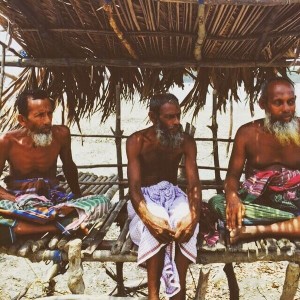Climate Change – Lost of Livelihoods – Urbanization Action is needed in Bangladesh.
 (Picture taken by Edouard Leonet – Khulna Bangladesh)
(Picture taken by Edouard Leonet – Khulna Bangladesh)
Bangladesh is globally recognized for being the country that is the most vulnerable to the impacts of climate change. The regular natural hazards that damage the country – heavy monsoon rainfall, tropical cyclones, flood and river erosion are set to experience an increase in frequency as a dramatic consequence of global warming. A situation that has become inevitable, a constant struggle for the millions of people living in Bangladesh.
Further to this Bangladesh is one of the world’s most densely populated nations, with an estimated population of 152,4 million. The life expectancy at birth is around 71 years (2013). The human development index report has ranked Bangladesh number 142 of 187 nations.
It is clear at this point, that the adverse impacts of climate change has heavy repercussions for Bangladesh’s development and economy. However, one of the biggest challenges that the country is currently faced with and will face in the futur is the forced migration of people towards the capital – Dhaka.
How climate change affects the most vulnerable sector of the Bangladesh economy ?
Bangladesh, being one of the most disaster prone countries in the world, is at the forefront of climate change. The harsh impacts of hotter temperatures, sea level rising and monsoon becoming irregular are already being experienced in Bangladesh. These so called impacts have resulted in progressive changes such as the variability in the climate and an increase in extreme events, for instance storms, floods and droughts. In the next section, we will see how these changes in the climate have impacted an essential sector in Bangladesh’s economy – agriculture, and the effect it has on the people who are engaged in such activities.
Over the years, the agriculture sector has observed major setbacks with regards to the direct effect of climate change. An issue that has become a global concern, however for Bangladesh it is a matter of national food security. Indeed, the agriculture sector plays a vital role in the Bangladeshi economy. According to the last available statistics, this sector encounters for 13% of the GDP (2013- 2014). This might seem like a small slice of their economy, however it is essential to underline that an amazing 2/3 of the population (roughly 100 million people) are engaged within this sector.
Agricultural crops in Bangladesh are influenced by the various seasonal characteristics and of course the many variables of the climate, for instance humidity, temperature, rainfall and the length of the day. However, with the increased frequency of natural disasters the country has experienced, the production of crops is often constrained. To put in another way the climate and agriculture are interconnected, therefore when a small change in one variable occurs it will automatically provoke a change among the other variables, which will affect the productivity of the operation. Additionally, constant instability of the climate makes it extremely difficult to plan agricultural operations.
Further to this the sea level rising has become an increasingly severe threat to the coastal agriculture farmland. According to the NyTimes : « The country’s climate scientists and politicians have come to agree that by 2050, rising sea levels will inundate some 17% of the land and displace about 18 million people. » I belief this highlights the importance and the urgency of this issue, as so many lives are at stake !
It goes without saying that the rural communities (66% of the population in 2014) are dependent on agricultural activities as a vital source of income or livelihood. However, as the impacts of climate change increases the agriculture sector becomes increasingly vulnerable. We can now ask ourselves, what impact this has on these exposed communities ?
Population migration and living conditions.
As mentioned previously many inhabitants of Bangladesh especially the rural communities are reliant on farming activities to earn the barest of living. With this in mind and as the impacts of the climate increases in intensity, people are struggling to make ends meet, in other words they are no longer able to live and earn their livelihoods from their agricultural labor. As a result of this, we have seen over the years a massive influx of people leaving their respective villages to settle in Dhaka with a hope of a better life.
In the past, people would make their way to the city in order to earn some sort income and then return to their home villages. According to Friendship, a valued based NGO in Bangladesh that has a holistic approach to development ; today between 2000 to 3000 people daily leave their countryside to migrate to Dhaka (Friendship NGO). As a matter of fact the IPCC (Intergovernmental Panel on Climate Change) has projected that around 20 million individuals will be displaced in Bangladesh in the next 5 years – climate refugees ! Further research states that most of the migrants arriving to Dhaka hail from the southern coastal area, as stated previously rising sea level, water salinity and floods have become the daily struggle for million’s of Bangladeshis. Indeed the International Organisation for Migration (IOM) has predicted that 70% of Dhaka’s slum-dwellers have migrated due to environmental hazards.
The term « overpopulated » is often used to describe the capital of Bangladesh. Dhaka is currently the fastest growing megacity in the world with approximately 15 million inhabitants on less than 325 square kilometers. A density of 115,000 people per square mile. A city that faces many challenges, a city on the brink of collapse. The Bangladeshi capital is not controlled in any way, with very little and effective work put into the urban planning of this metropolitan sprawl. Dhaka consists of urban slums who are harmful for the sustainable development of the city as nothing is well organized. With hardly any laws in place to design and maintain sewage drains, garbage dumps and of course industrial waste, the city has become chaotic. Additionally buildings are constructed aimlessly for the advantage of a few privileged individuals but at the cost of the community. This underlines another important issue in Bangladesh – corruption. Transparency International a corruption measurement tool has ranked Bangladesh 145 out of 175 countries as of 2014. Unfortunately considered as « a way of life » in the country, corruption is everywhere and has become a serious obstacle to a healthy development.
Nonetheless many Bangladeshi’s migrate to Dhaka with a hope to find security and job opportunities, even though Dhaka is far from being a promised land.Naturally for the people coming from rural areas ; a city often comes with more opportunities and benefits for instance better healthcare services and education for children. Yet what really happens is that people exchange their countryside poverty with poverty within the city as they cannot afford any essential services.
Considered as « illegal » by the government due to their housing status, they do not in any case receive any basic services, as a result of this the slum – dwellers see their living conditions deteriorate. Access to acceptable sanitation and water quality are non – existent. Additionally garbage collection is inconceivable – which in many cases becomes a breeding ground for insects and mosquitos. Cooking facilities are very basic and represent a dangerous threat to the slum inhabitants as they become increasingly exposed to indoor pollution. This is the rough reality of the slums of Dhaka with entire families living under 2$ a day, which in the long-run represents a high risk of malnutrition for infants and children. According to water.org, an organisation trying very hard to address the water crisis in the slums of Dhaka « thousands of episodes of diarrhea occur in children and adults each day ». A problem that is directly linked to the socio – economic conditions in which slum – dwellers live in, a problem needing immediate attention !! Further to this overcrowding in the slums is an urgent issue to tackle too as it poses significant amounts of stress on its inhabitants, who can turn to violence and drugs as a way to escape the harsh reality they are faced with.
A sad reality that has become the every – day life of millions of Bangladeshis, a life without dignity.
Action is needed !
In Bangladesh, the term « urbanization » is a consequence of an erratic rural economy, which is of course closely linked to the dramatic impacts of climate change. There is no more doubt in saying that that greatest threat human’s currently face in the 21st century is climate change ! A few weeks ago history was made with regards to the COP21 held in Paris. Indeed 195 nations agreed to combat climate change and to take action vis – à –vis a low carbon, resilient and sustainable future. I do not in any case undermine this great achievement but looking back on the agreement it is supposed to kick start in 2020. Time is of the essence, we cannot afford to wait any longer to put in place strong actions to tackle the climate change issue. This is especially critical for disaster prone countries like Bangladesh, as so many lives and livelihoods are at stake. The government of Bangladesh is currently overwhelmed with the massive influx of climate refugees in Dhaka, strong measures need to be taken with respect to the urban planning of their capital, as the city is on the verge of collapse.
The power of change and action in Bangladesh are in the hands of the current politicians – can we hope to inspire them to do the right thing ?
Edouard Leonet
Reference list :
UNDP Bangladesh. (04/2014). UNDP Regional Director commends community-led development approach in urban programming. Available: http://www.bd.undp.org/content/bangladesh/en/home/presscenter/pressreleases/2014/05/18/undp-regional-director-commends-community-led-development-approach-in-urban-programming.html. Last accessed 05/01/2016.
Tarannum Dana. (2011). UNHYGIENIC LIVING CONDITIONS AND HEALTH PROBLEMS: A STUDY IN SELECTED SLUMS OF DHAKA CITY.International Development Agency. Unknown (3), 27;28;29;30.
World Bank . (2014). Bangladesh – country at a glance. Available: http://www.worldbank.org/en/country/bangladesh. Last accessed 02/01/2016.
Transparency International . (2014). Corruption by country – Bangladesh. Available: https://www.transparency.org/country/#BGD. Last accessed 02/01/2016.
Gardiner Harris. (2014). Borrowed time on disappearing land . Facing Rising Seas, Bangladesh Confronts the Consequences of Climate Change. Unknown (Unknown), 1-3.
Cities Alliance. (2014). CLIMATE MIGRATION DRIVES SLUM GROWTH IN DHAKA. Unknown. Unknown (1), 1.
Global Climate Change Alliance. (2014). The Bangladesh Climate Change Resilience Fund (BCCRF). Available: http://www.gcca.eu/national-programmes/asia/gcca-bangladesh-climate-change-resilience-fund-bccrf. Last accessed 18/12/2015.




.png)
].gif)
.png)
].png)
].png)
].png)
.png)
].png)
.png)
